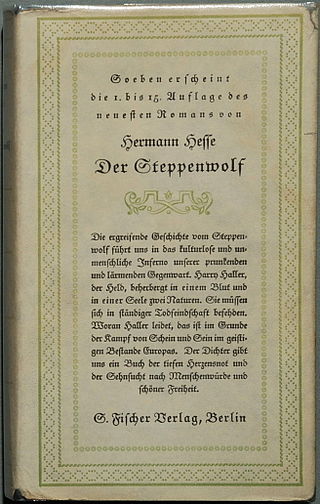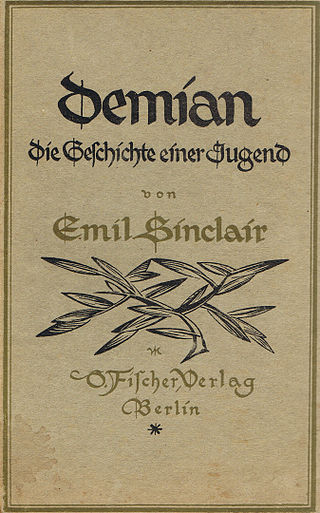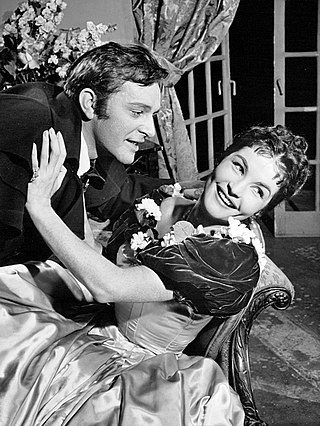
Hermann Karl Hesse was a German-Swiss poet, novelist, and painter. Although Hesse was born in Germany's Black Forest region of Swabia, his father's celebrated heritage as a Baltic German and his grandmother's French-Swiss roots had an intellectual influence on him. He was a precocious, if not difficult child, who shared a passion for poetry and music with his mother, and was especially well-read and cultured, due in part to the influence of his polyglot grandfather.

Memnoch the Devil (1995) is a vampire novel by American writer Anne Rice, the fifth in her Vampire Chronicles series, following The Tale of the Body Thief. In this story, Lestat is approached by the Devil and offered a job at his side.

Steppenwolf is the tenth novel by German-Swiss author Hermann Hesse.

Jasmine is a novel by Bharati Mukherjee set in the 1980s about a young Indian woman in the United States who, trying to adapt to the American way of life in order to be able to survive, changes identities several times. Mukherjee's own experiences of dislocation and displacement in her life helps her in recording the immigrant experience of the protagonist in this novel.

Siddhartha: An Indian novel is a 1922 novel by Hermann Hesse that deals with the spiritual journey of self-discovery of a man named Siddhartha during the time of the Gautama Buddha. The book, Hesse's ninth novel, was written in German, in a simple, lyrical style. It was published in the United States in 1951 by New Directions Publishing and became influential during the 1960s. Hesse dedicated the first part of it to the French writer Romain Rolland and the second part to Wilhelm Gundert, his cousin.

The Glass Bead Game is the last full-length novel by the German author Hermann Hesse. It was begun in 1931 in Switzerland, where it was published in 1943 after being rejected for publication in Germany due to Hesse's anti-Fascist views.

Demian: The Story of a Boyhood is a bildungsroman by Hermann Hesse, first published in 1919; a prologue was added in 1960. Demian was first published under the pseudonym "Emil Sinclair", the name of the narrator of the story, but Hesse was later revealed to be the author; the tenth edition was the first to bear his name.

Shantaram is a 2003 novel by Gregory David Roberts, in which a convicted Australian bank robber and heroin addict escapes from Pentridge Prison and flees to India. The novel is commended by many for its vivid portrayal of life in Bombay in the 1980s.

The Adolescent, also translated as A Raw Youth or An Accidental Family, is a novel by Russian writer Fyodor Dostoevsky, first published in monthly installments in 1875 in the Russian literary magazine Otechestvennye Zapiski. Originally, Dostoevsky had created the work under the title Discord.

Way of the Peaceful Warrior is a part-fictional, part-autobiographical book based upon the early life of the author Dan Millman. The book has been a bestseller in many countries since its first publication in 1980. The book initially had only modest sales, before Hal Kramer came out of retirement to republish the book, from the H. J. Kramer imprint of New World Library. In early 2006, a film based on the novel, Peaceful Warrior, was released.
The Morgesons is a novel written by Elizabeth Stoddard in 1862. A female bildungsroman, it traces the quest of a young woman in search of self-definition and autonomy. The novel comments upon the oppression of women in mid-nineteenth-century New England and challenges the religious and social norms of the time.

The Book Thief is a historical fiction novel by the Australian author Markus Zusak, set in Nazi Germany during World War II. Published in 2005, The Book Thief became an international bestseller and was translated into 63 languages and sold 17 million copies. It was adapted into the 2013 feature film, The Book Thief.

Catherine Earnshaw is the female protagonist of the 1847 novel Wuthering Heights written by Emily Brontë. Catherine is one of two surviving children born to Mr. and Mrs. Earnshaw, the original tenants of the Wuthering Heights estate. The star-crossed love between her and Heathcliff is one of the primary focuses of the novel. Catherine is often referred to as "Cathy," particularly by Heathcliff.
Ninon Hesse was an art historian and Hermann Hesse's third wife.
A "journey of self-discovery" refers to a travel, pilgrimage, or series of events whereby a person attempts to determine how they feel, personally, about spiritual issues or priorities, rather than following the opinions of family, friends, neighborhood or peer pressure. The topic of self-discovery has been associated with Zen.

Flight without End is a 1927 novel by the Austrian writer Joseph Roth.
Stella Fregelius: A Tale of Three Destinies is a 1904 novel by the British writer H. Rider Haggard about a young inventor who falls in love with a mysterious stranger while he is engaged to another woman. As a novelist, Haggard is known primarily for his adventure novels. Among his most widely read and critically acclaimed novels are King Solomon's Mines, Allan Quatermain and She. After his publication of She, Haggard wrote at least one novel a year every year until his death in 1925.

Srikanta, also spelled Srikanto, is a Bengali novel written by Sarat Chandra Chattopadhyay. Published in four parts between 1917 and 1933, It has been described as Sarat Chandra's 'masterpiece'. The novel takes its title after the name of its protagonist, Srikanta, who lives the life of a wanderer.

Of One Blood: Or, The Hidden Self is a novel by author Pauline Hopkins that was serialized in The Colored American Magazine from November 1902 to November 1903, during the four-year period in which Hopkins served as its editor. The novel follows the adventures of Reuel, a mixed-race American, as he travels to Nubia from America searching for treasure. The novel explores issues of love, identity, trauma and spirituality through the perspective of the African-American community.

Knulp is a series of three tales by Hermann Hesse, published in 1915 by S. Fischer Verlag. The three tales chronicle the life of a vagrant named Knulp. Hesse wrote them between 1907 and 1914, and they are considered to be part of his “Gerbersau” cycle of works.
















